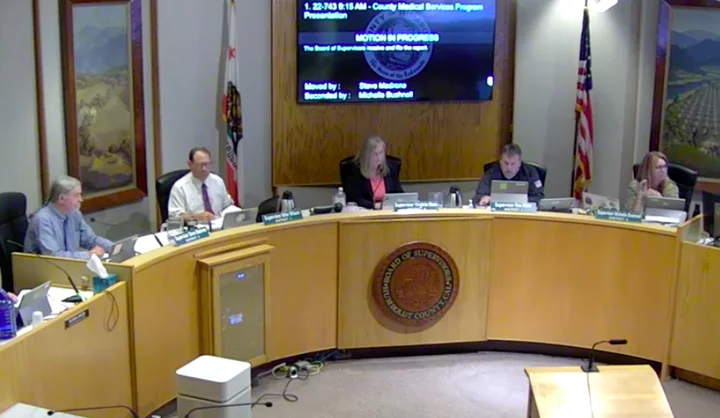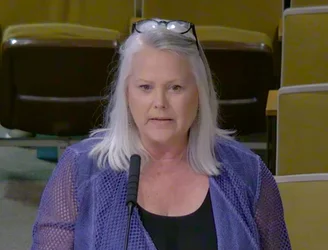
The Humboldt County Board of Supervisors (from left): Steve Madrone, Mike Wilson, Virginia Bass, Rex Bohn and Michelle Bushnell. | Screenshot.
###
Despite a recent change in leadership, Nordic Aquafarms plans to move forward with its land-based fish farm on the Samoa Peninsula. The Humboldt County Board of Supervisors received an update on the trajectory of the project during this morning’s regular meeting.
During a presentation to the board, Planning and Building Director John Ford briefly acknowledged the unexpected departure of the company’s founder and president Erik Heim and his wife, Executive Vice President/Commercial Director Marianne Naess, but focused his attention on the Final Environmental Impact Report (FEIR) for the project that was released just days before the couple parted ways with the company.
The 1,080-page document, which was prepared by GHD engineering, addresses the project’s anticipated environmental impacts and responds to hundreds of comments submitted by the public and various regulatory agencies following the release of the Draft Environmental Impact Report (DEIR) in December.
Many of the comments were repetitive, Ford said. Rather than “responding the same way over and over again” to each question, GHD opted to include a list of “master responses” to common issues including energy usage, greenhouse gas emissions, truck traffic/road safety, fish escape, marine outfall, waste handling/disposal and the composition of the fish feed.

Chandler | Screenshot
Nordic’s interim CEO and former Maine-based Chief Financial Officer Brenda Chandler was present during this morning’s meeting and introduced herself to the board. “[I’m] still getting up to speed on many of the aspects for California,” she said. “I have a great team behind me — those that have been working through the FEIR process and the other permits that are required for the fish farm to proceed. I just wanted to thank everybody [who has worked on this project] up to this point and we plan on continuing with a great team.”
Supervisor Mike Wilson acknowledged that the change in leadership “has raised some questions” from community members about the continuity of the project moving forward. “How are we feeling about this?” he asked. “[Should] we expect any other changes?”
Scott Thompson, Nordic’s local project manager, has worked on the project for the last two years and will continue to do so, Chandler said.
“Actually, we had already hired project leaders … for projects on both coasts – Belfast and Samoa,” she continued. “ I will continue to be the face of the organization … but that project lead had already been in place, essentially, and his name is Steven Sachs. He has worked on some very large projects on the East Coast and, in terms of the more technical aspects of all of this, he kind of picks up that leadership for project management with Scott, or local person on the ground.”
Lynette Mullen, an independent consultant who has worked as a community liaison for Nordic in Humboldt County, addressed the board and emphasized that the change in leadership does not mean that the project itself has changed.
“I think it’s just important for people to know that the team working on this project has been mixed kind of on both coasts from the beginning. …The people on the ground doing the work are still here,” she said, referring to local engineering firms SHN and GHD. “The other thing that I think it’s important for people to know is that a lot of the agreements that have been put in place in the last couple of years working with environmental groups … and all those things really are in the FEIR.”
Supervisor Rex Bohn noted that the Belfast and Samoa projects would undergo construction at the same time and seemed to express concern about Nordic’s ability to finance two massive projects.
Chandler acknowledged that the company’s Norwegian facility only produces a fraction of the salmon that the Samoa facility would produce per year (1,000 metric tons per year compared to 23,000 metric tons per year) but said the difference “is how you scale it” because the project is modular.
Bohn seemed satisfied with that answer and said, “I love the program.” He added that he would like to see a few things change, but “overall it’s a great idea.”
Supervisors Steve Madrone and Michelle Bushnell asked about the next steps for the project and what happens after the Planning Commission’s July 28 hearing. Ford explained that a coastal development permit could be approved by the Planning Commission, but it could also be appealed to the Board of Supervisors or the California Coastal Commission.
“There’s a little bit of uncertainty there about what an opponent may want to do,” he said. “We don’t know that there are opponents who will appeal at this point, but those are the two options that would be available.”
Ford added that the Coastal Commission itself must issue permits for the plant’s water intake, as well as its discharge of water back into the sea.
Bushnell moved to accept the report. The motion was seconded by Wilson and approved in a unanimous 5-0 vote.
###
PREVIOUSLY:
- Final Environmental Impact Report for Nordic Aquafarms Project Released; Planning Commission Hearing Planned for Later This Month
- Top Executives at Nordic Aquafarms’ U.S. Operations Mysteriously Part Ways With the Company
- Nordic Aquafarms Announces New Interim President Following Sudden Departure of Top Execs
CLICK TO MANAGE